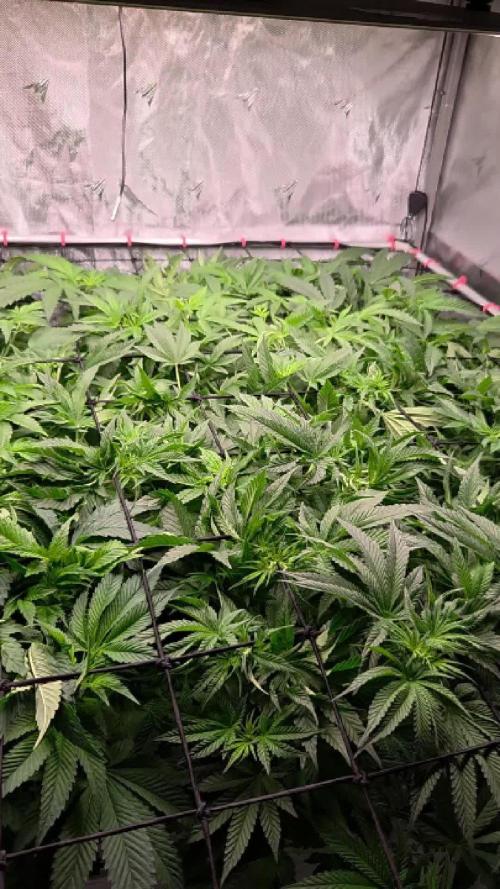The Grow Awards 2026 🏆 





































Likes
Comments
Share


@asstonmartian
Follow
Fourthish week of flower and they have begun to pray 🙏🏼 well, most of them anyways. The largest still is suffering from an untreated overwatering and over nuteing condition but the others are looking nice! The ones on the roof were in full prayer and loved the hot afternoon direct sun.
At this point, giving the flowers a squeeze rewarded you with sticky fingertips and a smell of stinky gouda cheese or similar. Crystals were starting to form on the sugar leaves which was exciting to watch for the first time. I was thoroughly impressed with the prayer formation that these plants assumed when conditions were prime. Very cool! You could see how the plant was able to maximize leaf surface area exposure while blocking the least amount of light from the leaves below.
The light was being run on 100% and temps would be between 83 and 85 degrees. I was OK running it a bit hotter as it's an LED light. I like the light a lot - especially it's precision. Each 25% dim increment correlated to 2 degrees temp change. Nice!
Likes
11
Share


@Chubbs
Follow
420Fastbuds
FBT2309/Week8
What up grow fam. I hope all is good with everyone. Week 8 update on these absolutely stunning girls. They're definitely progressing nicely with the flower sites swelling up. Super frosty and beyond sticky when you happen to touch them. Over all Happy Growing
Likes
15
Share


@Venabr96
Follow
Armario posto em fase de floraçao.
Rega de 4 a 4 dias com 2l de agua desmineralizasa.
Deixei a lampada cair sobre elas , piqueno incidente 😣😣
Mas esta tudo bem só perdi uma folha da piquena uma da grande e algumas queimaduras 😣😣
Likes
39
Share


@Hazecat_420
Follow
Se trasplanto de maceta 0.5 a maceta de 1 litro para poder ir colonizando el sustrato de a poco. El tallo que se está formando va bien, no se han espigado tanto, sus nodos están muy cercas uno del otro. Luego del trasplante se aplicó foliar Insta-Green de Grotek
Likes
6
Share


@The_Highdrated_One
Follow
Now its time to finish i have lollipop'd the plant. I did this with my Blueberry plant i used for clones and the remaining top growth has much larger fan leaves.
I am confident it will focus the energy in the right places and i wanted this wrong to have beautiful bud filled trim :) Gonna flush it for a week and a bit then create space weed. 24hr dry time haha
Likes
15
Share


@I_Identify_As_A_Dan
Follow
Week 6 for Gelato 41
Besides the sad injury she suffered from her accident (losing a main top branch), shes really starting to take off at a rapid pace wouldn't say its the same plant from the week before.
Shes definitely a bushy girl, the bottom branches have fully caught up to the tops. Going to start training her a bit size ways now as she clearly favours getting bushier.
Also gave her some outdoor sun for 3 days in a row as we had some cloudy days to start hardening off her leaves, but not fully transitioning fully outdoors just yet.
Likes
16
Share


@Mrg7667
Follow
Noticed what looks like to me a little nitrogen deficiency so started feeding biogrow at 2ml
2nd week with the new lights and they seem to enjoying it although space is getting very tight in my closet! Going to need to migrate to tent sooner then later
Likes
93
Share


@LGreen
Follow
🌿 Schönen Sonntag & einen entspannten 1. Advent aus der richtigen Zeitzone =)
🌱 Wochenupdate
Diese Woche wurde echt viel gefummelt 😄 Im Fokus standen Canopy-Aufbau und selektives Entlauben =)
Bin da wirklich pingelig und könnte das den ganzen Tag machen… echt schlimm 😅
Was ich jetzt schon sagen kann: Blueberry Cupcake hat mit Abstand den krassesten Stretch hingelegt.
Purpz hat ihren Platz auch relativ gefüllt, performt echt gut und ist fast gleichauf mit BBCC.
Notorious zieht auch, soll aber wohl etwas später definierter drücken. Mir gefällt ihr Wachstum richtig gut.
Guzzlerz macht sich auch echt gut für ihren schlechten Start.
Ihre Sides gehen mittlerweile richtig steil. Ein paar mehr Triebe wären nice gewesen, aber da lag sicher auch einiges an mir.. :D
Abseits meiner Dummheiten lief alles absolut smooth. Eine tolle Veg und richtig gute Stretch-Phase bis jetzt =D🔥
🌿 Pflanzenstatus & Training
Ich halte die Canopy aktuell noch flach – für zwei, drei Tage =) Anschließend steht das Verteilen auf die Meshes an. Danach dürfen sie endlich nach oben =D
Die Richtungen sind grob gelegt, erste Ansätze sieht man auch schon =D Ich kann’s echt nicht erwarten… Budporn ist einfach magisch 😄🔥
Über die Tage sind immer wieder größere oder verdrehte Blätter rausgeflogen – hauptsächlich, um Luft und Licht auf möglichst viele Triebe zu bekommen 😊
Man kann wirklich ohne Bedenken ~30 % Biomasse rausnehmen, wenn die Vitalität das zulässt, ohne sichtbaren Stop im Wachstum 🌱
🌬️ Luft & Ventilation
Hab jetzt noch zwei Clip-Ventis dazugezogen. Die Angst vor Schimmel kickt langsam wieder =D
Es laufen jetzt zwei unter und zwei über der Canopy – jeweils gegenüberliegend und zirkulierend.
Ich muss gestehen, dass ich den Boundary-Layer-Disruption-Effekt kenne bzw. davon weiß, und ihn durchaus stimmig finde 😊 Aber bis jetzt war die Angst vor Schimmel in irgendeiner Ecke doch größer 😂
Ich hab nicht den Eindruck, dass es negativ ist, zirkulierende Luft auf die Pflanzen zu richten, solange man nicht voll draufpustet 💨
⚙️ System
Läuft nach wie vor stabil =) Die Top-Ups halten die Nährlösung sauber auf Kurs.
Gestern hat sich klar abgezeichnet, dass wir mitten im Stretch-Peak sind 😄 Sie ziehen massiv Kationen und verursachen dadurch einen deutlich messbaren pH-Drop.
Das ist für mich das Signal, das Training in den nächsten Tagen zu beenden 🌿😊
800 PPFD
1,0 kPa VPD
700–800 ppm CO₂ im Durchschnitt
💚 Special Mention
Der Aufwärtstrend setzt sich fort 😊 Man mag es kaum glauben, aber sie macht sich wirklich gut – sie deckt sogar etwas mehr als die Hälfte ihres Quadranten ab 💚
Bin echt froh, dass sie es geschafft hat und meinen Scheiß noch mitgetragen hat 😂
Danke fürs Lesen echt verrückt, wie viele inzwischen dabei sind – freut mich wirklich mega 😊💛
Eine schöne, entspannte Adventszeit euch allen 🌲😊
Likes
15
Share


@Messypies
Follow
brilliant week of growth from the peanut butter cookies. Been a little bit of a struggle for space but will HST once all autoflowers are out.
Both the auto cinderella jack and auto critical cheese are developing buds nicely
Likes
49
Share


@FoTwenny
Follow
🗓️ Week 17: 3/23 - 3/29
📆 Week 7 of 12/12
🌄 The plant is starting to go into senescence and presenting some beautiful colors as she begins to fade.
💡 Received new lighting courtesy of Growers Choice. They sent me the ROI-E420 with the Master Controller. First impression is amazing. Looks and feels like very high quality build. The spectrum seems more blue than the 3000k lm301H Kingbrite bars I have been using. The bars are thinner and packed with a lot of diodes, so they do run a little hotter than the KB at full power. I adjusted and now running them at 90%. For now the Kingbrite bars are being used as side lighting dimmed to about 30-35% depending on Grow room temps.
Likes
3
Share


@Homestickycannabis
Follow
She's popp'n and whew were!!! This is an amazing strain. Thankfully I have more beans and the next round clones will be taken for sure. This is one of those that a wise commissure would keep a permanent spot in his or her line up. And these were bag seed of a strain that I was informed that's not available in seed or clone. I may be wrong but the quality of this strain tells me all I need to know!!!
Likes
17
Share


@JohnnyBarrel
Follow
Week 17
Nothing really moved this week. It’s something like between low tide and high tide: not my favorite moment … waiting for blossoms and flowers 🙄🙏.
Good point is that every plants are healthy ( except a parasite problem on Psicodelicia) and well
prepared for flowering.
For now it’s bad weather outside: 20 degrees max, with lot of wind and rain (cf video). The green house is the best option despite of less exposure.
Morning soon I moved the plants outside to sprayed them with potassium soap (natural insecticide). I cleaned the grow space inside the greenhouse (didn’t touch spiderwebs…good insecticide too).
I removed the automatic watering and get a few liters of rain water during this days.
Watering 1L every 3 days
-Calmag + Cannazym + Alga mic + Root booster
-Flora Series: preflowering quantities.
Daylight 14h30: 6h50/21h20
Sleepy Joe is still the queen of this summer session, using a large place with the long side branches. Zero problems but I did some preventative treatment against predators.
Likes
18
Share


@Dunk_Junk
Follow
Wow she's still growing nicely!!
27cm more this week!
She's looking nice.
Likes
1
Share


@Day_1
Follow
This week after adding bone meal and worm castings, the girls reacted great. Their loving the environment and growing fast!!
Likes
7
Share


@ToRuL88
Follow
Última poda de bajos. Hago 3 riegos a la semana 700-800ml repartiendo fertilizantes. Último riego siempre agua, calmag y sensizym únicamente. He medido ec sustrato y da 2.4, un poco alto pero parece que lo soportan bien.
Sino me equivoco quedan aún 7 días de prefloracion (crecimiento) mínimo. Creo que pueden llegar a los 90-100cm. He podido contar en 25 plantas como 80-90 ramas a la misma altura, creo que el Scrog ha servido para organizar bastante. Nos vemos próximamente 😘
Likes
19
Share


@EmeraldLakeCannabis
Follow
Nice start to the week, enjoying the growth on these so far. The Carl #2 seems to be a triploid mutant, should be fun to grow. Been experimenting with time lapses over the last little while and think I may finally have it down at this point.
/Updates as they happen/
-Carl is more than a triploid, both seeds have four-leaf node sets
-Had to support UKBS 2 with some garden ties as it got too leggy and started falling over
-Watered with plain water, the seedlings are suffering under the low humidity but growth remains steady
Likes
18
Share


@NeoCat
Follow
It's almost finishing time 😎 This girl is beautiful and the nugs look like pillows.
This FastBuds variety is much smaller than the RQS version but the nugs look very different to each other. Check out my other diary and see what you think.
Next week I will flush and then harvest 😀
Likes
80
Share


@Roberts
Follow
The pure Ice cream clone has been growing nicely and doing her thing. I did move her back to the SE3000 tent. She is steady growing, and likely needs a bigger potter very soon. Everything has been going great. Plus the other clone finally started to grow. It is showing deformities, but it is growing now. Thank you Spider Farmer, and Pure Instinto Seeds. 🤜🏻🤛🏻🌱🌱🌱
Thank you grow diaries community for the 👇likes👇, follows, comments, and subscriptions on my YouTube channel👇. ❄️🌱🍻
Happy Growing 🌱🌱🌱
https://youtube.com/channel/UCAhN7yRzWLpcaRHhMIQ7X4g
Likes
321
Share


@Tropicannibis_Todd
Follow
🤔🤔🤔🤔🤔 HAPPY GROWING 🤔🤔🤔🤔🤔
(👉Bonus Video Showcases Everything I Have Going on in TropiCannibis HQ 👈)
We are now 54 Days into flowering and everything is going great 👍 👈 We are now playing the waiting game👌
Just waiting on the tricomes to amber up a bit 👈
👍 decided to showcase the Mini BigBand , was a extra seed that germed so I kept it as a Mini Me 😊 She's killing it 👈
Except for some watering it's been pretty smooth I've done a little maintenance and manipulation of the canopy 👈
👉Soil Medium Provided by ProMix.ca
👉Nutrients Provided by Agrogardens
👉Lighting Provided by MarsHydro.ca
I would like to thank the many growmies for support throughout the years 🙏 So Let's Do This 👊👊👊 Happy Growing



















